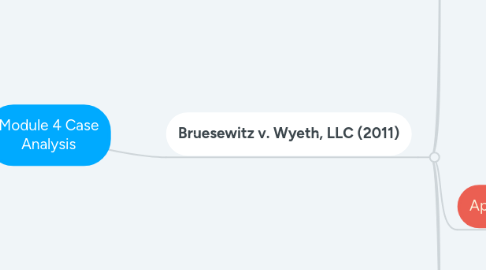
1. Bruesewitz v. Wyeth, LLC (2011)
1.1. Facts
1.1.1. Parties
1.1.1.1. Russell and Robalee Bruesewitz , parents of Hannah Bruesewitz
1.1.1.2. Wyeth, Inc, vaccine manufacturer
1.1.2. What Happened
1.1.2.1. Hannah Bruesewitz received three (3) doses of a Wyeth manufactured childhood vaccine for Tri-Immunol DTP vaccine.
1.1.2.1.1. DTP is intended to vaccinate against whooping cough
1.1.2.2. Shortly after administration of the vaccine, Hannah began experiencing seizures.
1.1.2.2.1. Her parents counted 126 seizures over a 16-day period
1.1.2.3. Doctors diagnosed Hannah with a residual seizure disorder and encephalopathy
1.1.2.3.1. Encephalopathy is a term for any diffuse disease of the brain that alters brain function or structure. Encephalopathy may be caused by infectious agent (bacteria, virus, or prion), metabolic or mitochondrial dysfunction, brain tumor or increased pressure in the skull, prolonged exposure to toxic elements (including solvents, drugs, radiation, paints, industrial chemicals, and certain metals), chronic progressive trauma, poor nutrition, or lack of oxygen or blood flow to the brain. (Encephalopathy Information Page | National Institute of Neurological Disorders and Stroke)
1.1.3. Procedural History
1.1.3.1. US Court of Federal Claims, Vaccine Court
1.1.3.1.1. Petition was denied for failure to prove linkage between Hannah's health problems and the vaccine.
1.1.3.2. Pennsylvania State Court, 3rd Circuit Court of Appeals
1.1.3.2.1. A petition for a writ of certiorari was granted, bringing the case to the Supreme Court.
1.2. Issue before the Supreme Court
1.2.1. Whether the Third Circuit erred in holding that, contrary to its plain text and the decisions of this Court and others, section 22(b)(1) preempts all vaccine design defect claims, whether the vaccine’s side effects were unavoidable or not?
1.3. Rule of Law
1.3.1. National Childhood Vaccine Injury Act of 1986 (NCVIA)
1.3.1.1. §300aa–22(b)(1)
1.3.1.1.1. supersedes all product liability and negligence common law enforcements
1.3.1.2. created a no-fault compensation program to stabilize a vaccine market adversely affected by an increase in vaccine-related tort litigation and to facilitate compensation to claimants who found pursuing legitimate vaccine-inflicted injuries too costly and difficult. https://www.supremecourt.gov/opinions/10pdf/09-152.pdf
1.4. Application
1.4.1. Appellant and Appellees positions
1.4.1.1. Appellant
1.4.1.1.1. Wyeth was subject to 1. strict liability, and 2. liability for negligent design
1.4.1.2. Appellee
1.4.1.2.1. 42 U.S. Code § 300aa–22
1.4.2. Application of facts to legal requirements
1.4.2.1. the NCVIA eliminates the manufacturers liability for a vaccine’s unavoidable, adverse side effects.
1.4.2.1.1. The law essentially provides vaccine manufacturers full protections against any/all plaintiff product liability claims
1.4.3. Analogies or public policy arguments
1.4.3.1. "Vaccines are like the sacred cow" (describing their strong product liability exemptions)
1.4.4. Expansion/Reinterpretation/Narrowing of law to reach a conclusion?
1.4.4.1. the NCVIA requires no expansion, reinterpretation, or narrowing to reach a conclusion in this case
1.4.4.1.1. Directive is firm and unyielding in interpretation
1.5. Conclusion
1.5.1. Held: The NCVIA preempts all design-defect claims against vaccine manufacturers brought by plaintiffs seeking compensation for injury or death caused by a vaccine’s side effects. https://www.supremecourt.gov/opinions/10pdf/09-152.pdf
1.5.1.1. This conclusion is supported by the fact that, although products-liability law establishes three grounds for liability—defective manufacture, inadequate directions or warnings, and defective design—the Act mentions only manufacture and warnings. It thus seems that the Act’s failure to mention design-defect liability is “by deliberate choice, not inadvertence.” Barnhart v. Peabody Coal Co., 537 U. S. 149, 168.
1.6. Impact
1.6.1. This case has significant ramifications for the approximately 5,000 pending claims in an omnibus proceeding before the vaccine court alleging that childhood vaccines caused autism.
1.6.1.1. The Bruesewitz decision will likely restrict many of the claims to vaccine court and foreclose the possibility of a state tort law alternative for claims asserting that a defective design caused autism.
1.6.2. Cited in: Cedillo v. Sec’y of Health and Human Services, 617 F.3d 1328 (Fed. Cir. 2010)
1.6.2.1. Claims asserting a link between vaccines and autism have not generally been compensated in vaccine court under NCVIA because autism is not listed on the Vaccine Injury Table and due to the lack of credible medical evidence that vaccines cause autism.
1.7. Importance
1.7.1. vaccine manufacturers have far greater liability protections than other product manufacturers
1.7.1.1. Claims of liability and fault go through a separate claims court for recovery of punitive damages
1.7.2. portions of the population cease getting vaccinations for themselves and their familes
1.7.2.1. this presents risk of disease and illness outbreaks
1.7.2.1.1. vaccines only work as intended when vast majority of the population is vaccinated
1.7.2.2. could negatively affect financial performance of vaccine manufacturers
1.8. Influence
1.8.1. two current business practices that have been influenced by the holding
1.8.1.1. Business as usual for vaccine manufacturers
1.8.1.1.1. They should invest internally and partner with 3rd parties, including the Fed Gov, to continuously improve manufacturing processes and product testing
1.8.1.2. Societal opposition to vaccines
1.8.1.2.1. Other remedies, including natural remedies and/or "Hoping" to ensure children are safe from common diseases

